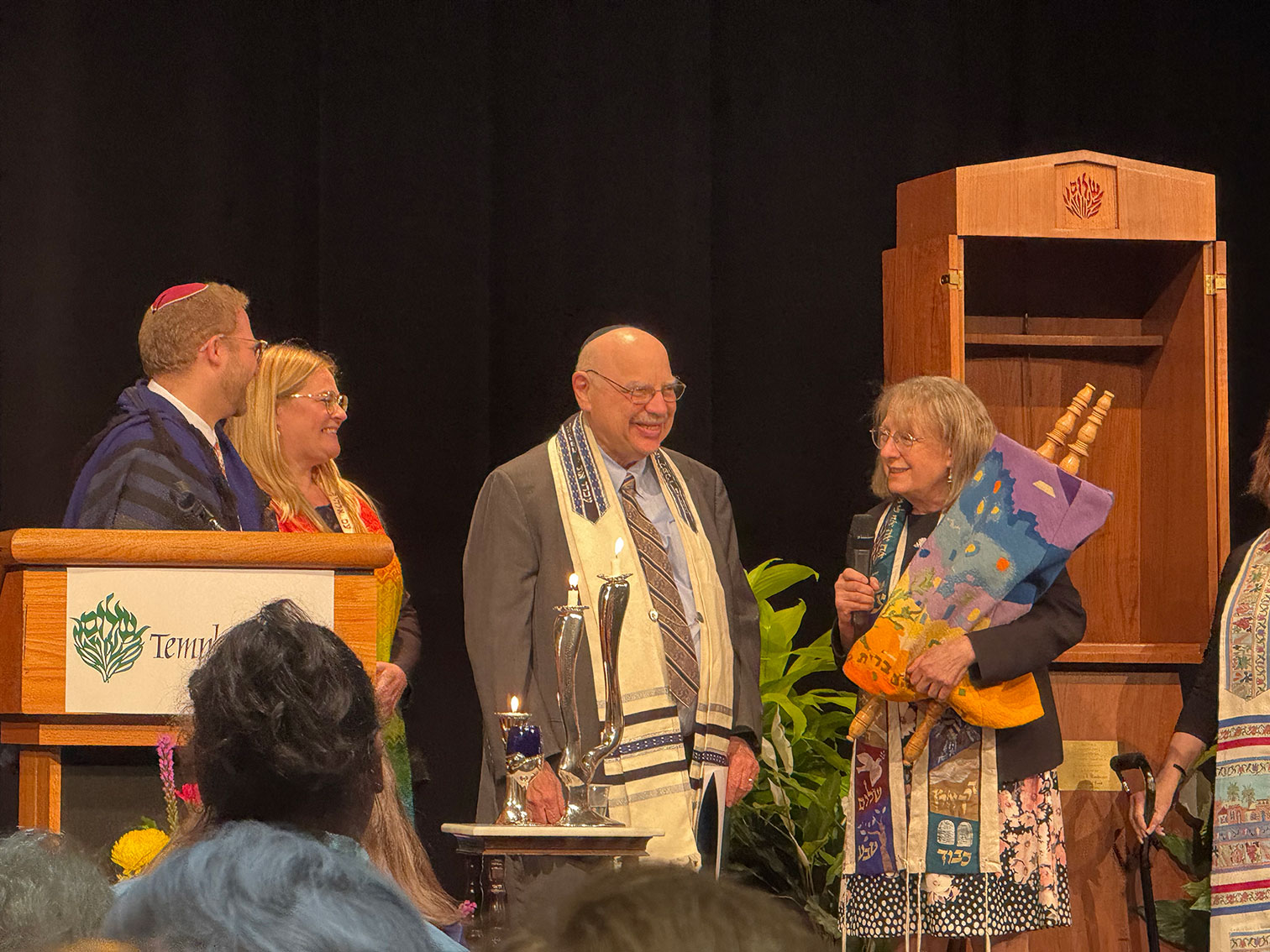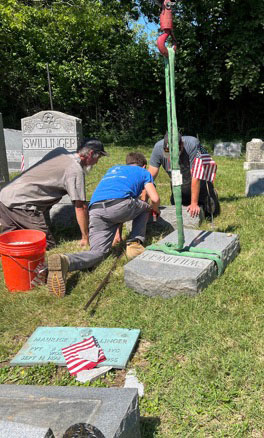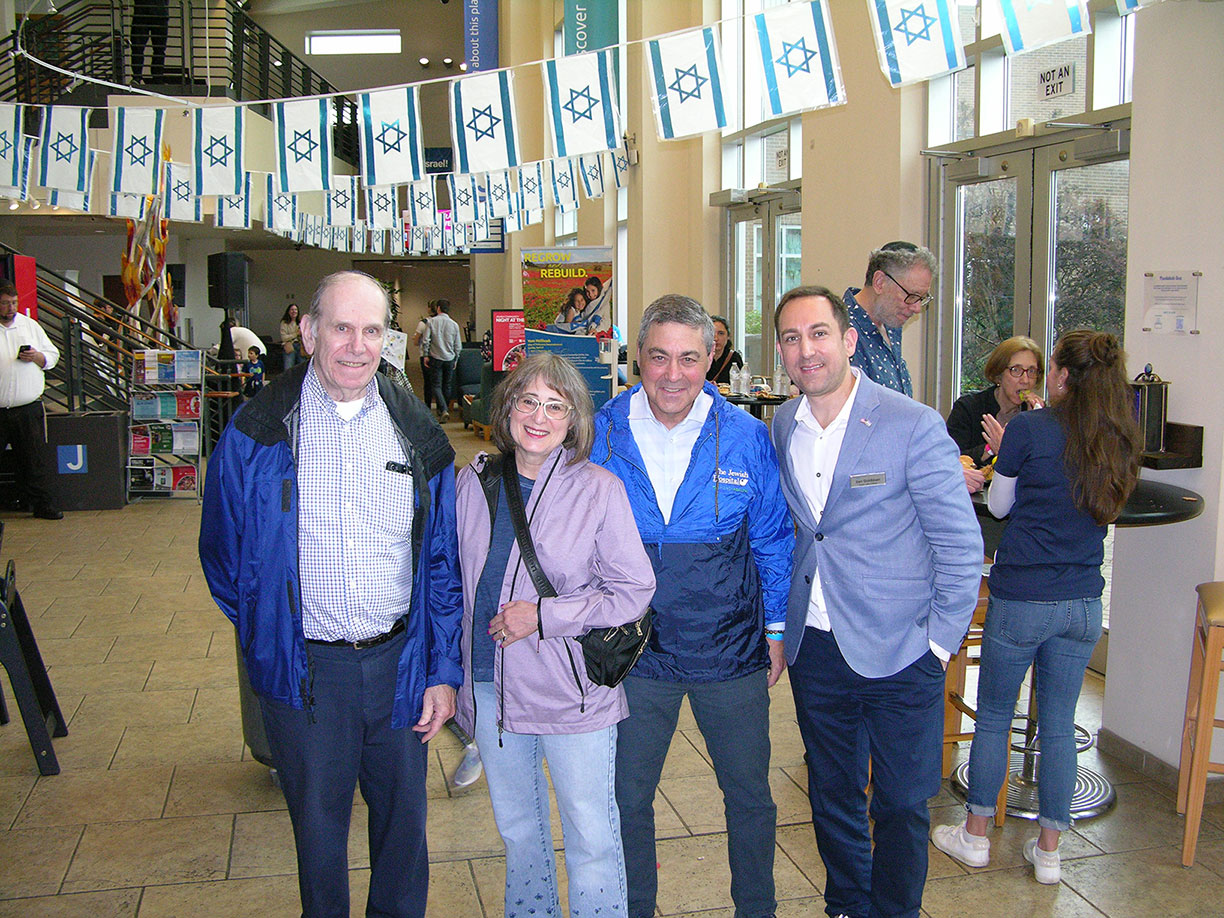
[L–R] Lisa MacVittie, Enno Zschiedrich, and Annette Lebowski share a happy moment during a 2022 Jewish Family Service (JFS) Hanukkah celebration. Lisa and Annette are clients of JFS’s Center for Holocaust Survivors. Enno, who is German, is JFS’s Action Reconciliation Service for Peace volunteer. He is here to meet with, listen to, and develop honest connections with Cincinnati Holocaust survivors.
Submitted by Jewish Family Service
As a native of Berlin, Enno Zschiedrich has been immersed in history his whole life. And not just any history; a precise history that is painful to remember, and dangerous to forget. Reckoning with this history is a central reason Enno came to Cincinnati, last September, as the Action Reconciliation Service for Peace (ARSP) volunteer for Jewish Family Service’s Center for Holocaust Survivors. While Enno knows his year-long commitment to JFS can never alter history, he hopes his work will lead to a more peaceful, just, and tolerant world.
When he was a boy, Enno’s football [soccer] club practiced and competed in Berlin Olympic Park — the stadium in which Adolph Hitler watched Jesse Owens win four gold medals in 1936. In school, Enno’s studies would regularly focus on the Holocaust and the scourge of Nazism. Berlin’s architecture also impacted Enno: the imperial overtones of the Brandenburg Gate, the Neo-Renaissance aspects of the Reichstag, the ironic elegance of the House of the Wannsee Conference — all different in style, yet similarly subsumed under Hitler’s Third Reich. Yet, in a recent interview, Enno said that no exposure to history taught him more than when a Holocaust survivor from Cincinnati looked him in the eye and shared her traumatic memories of being transported in a train’s cattle car as it was being strafed by bullets from low-flying German aircraft, while the train pressed east from Stalingrad.
Enno said that the ASRP initiative originated in Germany, roughly a decade after the end of the Second World War, and was born of the inextricable guilt German citizens felt for the crimes of their forebearers. “What has always been necessary to our understanding of this past,” Enno said, “is accepting that we were the ones who did terrible things to others. We were responsible. We were wrong, and we wronged others in a way that can never be made good again.”
Enno, who has been in Cincinnati since September, is a warm, compassionate, intelligent 20-year-old, whose innate worldliness belies his age. According to Meredith Davis, Director of the Center for Holocaust Survivors, Enno is the 16th annual ARSP volunteer to work with the program. “Enno approaches everything with enthusiasm,” Davis said. “He is outgoing and friendly, but has a deeply serious side, which really helps in this role. Watching him develop real relationships with our Holocaust survivor clients has been amazing. He works with our Friendship Club, assists with restitution applications, helps with German translations, and visits clients frequently. It’s been a true joy having him here.”
Part of the ongoing process of reconciliation—brought into sharp focus when one is an ARSP volunteer—is navigating one of the biggest questions of all: How could so many people have allowed themselves to be drawn into the Nazi maelstrom? Not surprisingly, Enno believes the answer is complicated. “So many people participated by looking away,” he said. “They didn’t want to risk their own head and their own future by speaking up against injustice.” Enno further noted how the answer to this question has shifted over time. Where Germans were once taught to demonize Nazis as a group that was distinct, abnormally evil, and a cultural outlier—current education stresses that they were ordinary human beings. “If you want to understand the Shoah,” Enno said, “it is essential to realize that it was done by people like me and you. If we think of them exclusively as monsters, we fail to gain perspective on how they became monsters.”
This inward-out perspective on those who perpetrated Nazi atrocities meshes with Enno’s philosophy toward history. “When we study history, it should always have a purpose,” he said. “And that purpose is to do better in the future. We can’t pretend that the Germans who did this were not humans; that is exactly what they had convinced themselves about the Jews. The best way we can help ensure that this will never happen again is to study ourselves, our weaknesses, our human nature.”
The cultural bridges Enno is hoping to help build would not be possible if personal bridges weren’t created first. Enno thinks he’s been able to do that in his role, though he is quick to give credit to his clients. “They’ve been incredibly gracious,” he said. “I can’t speak for them, but I sense they are happy to see how much Germany has changed. They saw it at its worst, and…” Enno paused for a moment as if gathering his thoughts, “I believe they enjoy having me around. They’ve certainly welcomed me with open arms.”
One especially strong personal connection was made when a client with the Center for Holocaust Survivors, Lisa MacVittie, realized that Enno’s home is in the same borough of Berlin that she and her family lived in 80 years earlier. In this borough, there is a poignant memorial called the Stolpersteine (“Stumbling Stones”). In Berlin (installations exist in many European cities), this memorial is comprised of roughly 6,000 brass plaques installed in the sidewalks—each commemorating a Jewish resident who was “vanished” during the Holocaust. Two of these plaques honor Lisa’s grandparents, with whom she celebrated her last Hannukah in Berlin during World War II. Enno says he knows the area very well, and is certain he has walked near their memorials.
Enno went on to describe how this connection with Lisa deepened through a common language. “It took some time,” he explained, “but one day, she started to speak to me in German—her native language—the language her mother spoke to her all her life. I know that it takes a lot of personal connection to feel comfortable enough with a person to speak German again after you’ve been through so much hardship from people who spoke that language.”
Another powerful connection was made when the client who evacuated from Stalingrad (she asked to remain anonymous) shared her story with Enno. “We have all watched movies and documentaries about the trauma of Stalingrad, but when a person looks you in the eye and tells you she was there — as a young child — in a cattle wagon on some freight train, and you see in her eyes, and she sees in your eyes that you grasp the power of what she is sharing — it feels so deeply touching to be a part of that connection. No history lesson can do as much as that.”
Details of this dramatic story help convey why Enno was so moved. The client, whom we’ll call ‘Sasha,’ had only just survived the Battle of Stalingrad — the deadliest single battle of World War II. Though the depleted German 6th army surrendered in early 1943, sporadic attacks from German forces continued. That spring, Sasha got help evacuating east across the Volga River, where she was guided by adults to the cattle car—the interior of which was noxious and dark. When the train started moving, a woman instructed everyone to lie down, shoulder-to-shoulder, on the car’s floor. Soon, Sasha heard German aircraft approaching. Before long, the planes were on top of them, dropping bombs. Sasha vividly remembers how — in an instant — sunlight pierced the darkness when bullets blew holes in the walls of the train car. Sasha realized that many would have died if they had not heeded the woman’s advice. But with the light, new dangers were revealed; the walls of the car were on the verge of collapsing. A young man of about 20 rose from the ground to help hold them in place. Sasha recalls making eye contact with this man. A moment later, a tremendous bomb blast ripped him from the train, and he was gone.
Sasha’s story was a unique epiphany for Enno, but he says every aspect of working with the Center for Holocaust Survivors has changed him forever, and for the better. “We have to keep talking about this,” he said. “It’s our collective responsibility to keep the memory alive and learn from the past. I can’t speak for Germany. I can’t speak for my generation. I can’t speak for anyone else but me. But ultimately, I think it always comes back to standing up against injustice. Standing up. Speaking up. Risking something.”




